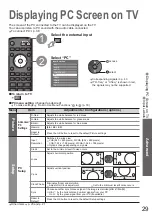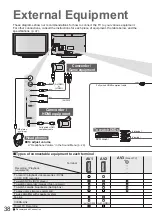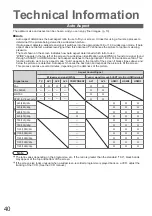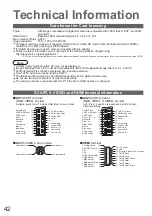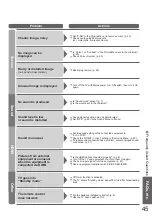
Signal name
Aspect Control Signal
Widescreen signal (WSS)
Control signal through SCART (pin 8) or HDMI terminal
TV
AV1
AV2
AV3
COMPONENT
AV1
AV2
HDMI1
HDMI2
HDMI3
PAL
O
O
O
O
O
O
PAL 525/60
-
-
-
-
O
O
M.NTSC
-
-
-
-
O
O
NTSC (AV input only)
-
-
-
-
O
O
SD
525(480)/60i
-
O
O
O
525(480)/60p
-
O
O
O
625(576)/50i
O
O
O
O
625(576)/50p
O
O
O
O
HD
750(720)/50p
-
O
O
O
750(720)/60p
-
O
O
O
1125(1080)/50i
-
O
O
O
1125(1080)/60i
-
O
O
O
1125(1080)/50p
-
O
O
O
1125(1080)/60p
-
O
O
O
1125(1080)/24p
-
O
O
O
40
Technical Information
Auto Aspect
Note
•
The ratio varies depending on the programme, etc. If the ratio is greater than the standard “16:9”, black bands
may appear at the top and bottom of the screen.
•
If the screen size looks unusual when a widescreen-recorded programme is played back on a VCR, adjust the
tracking of the VCR. (See the VCR manual.)
The optimum size and aspect can be chosen, and you can enjoy
fi
ner images. (p. 13)
■
Auto
Auto aspect determines the best aspect ratio to use to
fi
ll your screen. It does this using a four step process to
determine if the picture being viewed is a widescreen picture.
If Auto aspect detects a widescreen signal it switches into the appropriate 16:9 or 14:9 widescreen mode. If Auto
aspect does not detect a widescreen signal then this advanced TV enhances the picture for optimum viewing
pleasure.
The text shown on the screen indicates how Auto aspect determined which ratio to use:
“WIDE” appears in the top left of the screen if a widescreen identi
fi
cation signal (WSS) is found or a signal found
through a SCART or HDMI terminal. Auto aspect switches to the appropriate 16:9 or 14:9 widescreen ratio. This
function will also work in any aspect mode. “Auto” appears in the top left of the screen if black stripes above and
below the picture are detected. Auto aspect chooses the best ratio and expands the picture to
fi
ll the screen.
This process can take several minutes, depending on the darkness of the picture.




